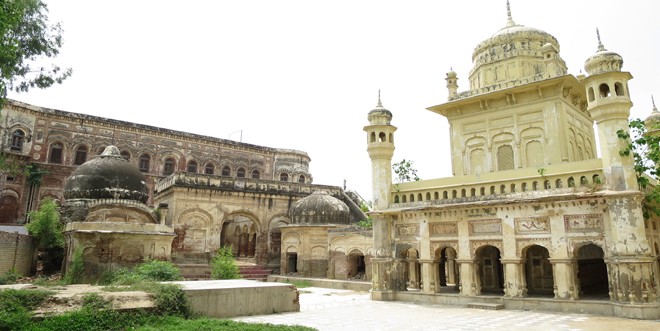
Just off Dipalpur, a haveli, gurdwara and dharamshala needs attention -- of both the travellers and government officials

Taking advantage of the long Eid break last month, I along with a couple of friends decided to explore the ancient Dipalpur Fort about a couple of hours drive from Lahore.
On reaching Dipalpur, we started inquiring about the whereabouts of the Dipalpur
Fort and to our amazement no one had a clue as to what we were talking about -- until a shopkeeper taking us for some ‘documentary-types’ directed us to a small village on Wasawaywala Road, by the name of Bhuman Shah.
After travelling on this scenic road, surrounded by potato and maize fields, for 15 minutes, we reached Bhuman Shah. To our surprise, it looked like a mini fort with a huge compound divided into residential quarters or haveli, a gurdwara or prayer area and a dharamshala or hostel for devotees. Presently, except for the gurdwara, local inhabitants are using all other buildings of the compound as residences with limited awareness for heritage conservation.
The haveli and some meditation rooms in the gurdwara appear to be built in late 18th century, however Samadhi and prayer hall appears to be newer constructions in comparison to the haveli.
The gurdwara and the two buildings are protected under the Anitquities Act 1974.
However, the only sign of the government possession of the gurdwara is a huge lock at the main gate -- though both visitors as well as schoolboys can enter through one of the broken walls either to explore the amazing gurdwara or play cricket in the main prayer hall, depending on their interests.
The haveli or residential compound is an imposing structure with its own ancient wooden gate. The outer walls are now in dilapidated condition but have intricate carvings and frescos and beautiful arches all around. The walls covered with frescos show various scenes from the Sikh history as well as carved embellishments showing human faces, beasts as well as shapes depicting jinns.
The entry to the haveli is restricted to only women as some Pathan families now reside inside it.
The other interesting building is the dharamshala or a hostel for the devotees. The building appears to be built at a later stage when the number of devotees to Bhuman Shah increased. This too is being used by local families as residential quarters.
Locals said that Sikhs come here to pay their respects frequently. The gurdwara has a meditation cell or samadhi in the centre. The samadhi has a Mughal character with tall minarets at all corners probably as a result of centuries of Muslims, Sikhs and Hindus living together in peace and harmony. The samadhi has some amazing frescos on its marble walls with scenes of a royal darbar, hunting expeditions etc. -- still quite well preserved.
Some of the marble walls with frescos appear to have been displaced or stolen.
The main prayer hall too is well kept. There is a proper marble stage for the prayer leader as well as a gallery for those devotees who cannot find space on the ground floor. The prayer hall was inaugrated in 1910, however, it seems that it is currently being used for some in-house cricket by the local youth.
As the story goes, Bhumia was a 17th century saint born in 1687 in Behlolpur village of Dipalpur. At an early age, he got inducted into Udsai Sainthood of Sikhs and was renamed as Bhuman Shah. The tales of his miracles spread to a vast area and earned him a fair share of devotees. Bhuman Shah apparently got released a local Wattoo landlord from prison using his magical powers and, in turn, was awarded a vast landholding by the landlord -- hence the Bhuman Shah village.
Bhuman Shah died in 1762 and through out his life preached the message of peaceful co-existence and universal brotherhood, earning him not only Sikhs but also Muslim and Hindu devotees.
After 1947 Partition, the descendents of Bhuman Shah migrated to Haryana in India and the gurdwara, along with the associated property, was practically abandoned.
Some of the Bhuman Shah disciples practice his teachings in Haryana as well as Dehradun.
It would not be too much to ask from the government to preserve Bhuman Shah and other Hindu and Sikh heritage sites with a proper heritage conservation plan. The government should appoint guides who also act as watchmen at these sites and the local administration as well as tourism departments should run a communication campaign around these heritage jewels scattered all over Pakistan.
On return from Bhuman Shah, we were able to find Dipalpur Fort on our own but that is story for another time.